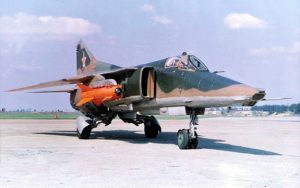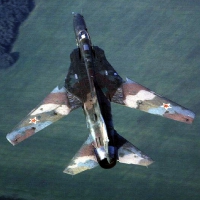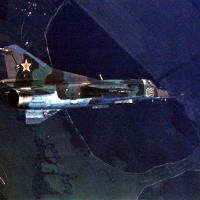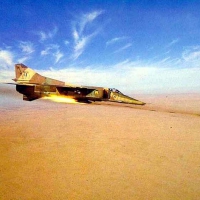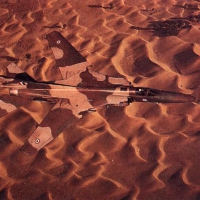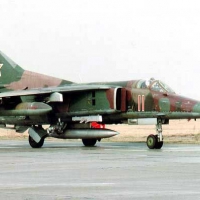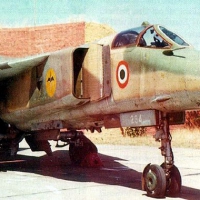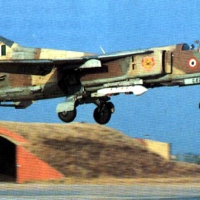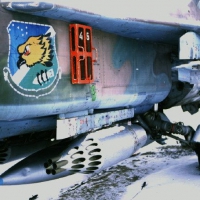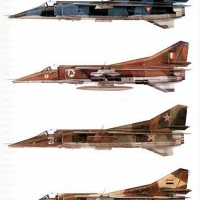MiG-27 Flogger D
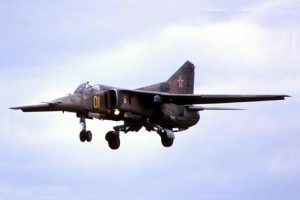 In the late 1970s, the MiG-23-influenced ground-attack aircraft, the MiG-27, entered service with the Russian military air forces. Faithful to the progressive trend in the military, it is a more-powerful, yet not-neccessarily-as-swift, fighter. The concept of variable-geometry was not new to the Soviets, and was conceived several years before and integrated into the design of the MiG-27 Flogger’s forerunner, and in Sukhoi’s Su-7. Its great advantages are found one, for the pilot, for whom is afforded smoother acceleration, and for the craft, which can lift within a smaller runway space and carry more cargo for greater distances. The MiG-27’s family ranges from its initial version to the K model and beyond, and its different models include features like fixed air engine intakes, and dual-position afterburners. The plane also contains modifications such as a guidance system for combat within inclement weather or at night, and an aft-position tracker. Other characteristics of the improved MiG-27 are, within its electronics system, an active countermeasures jammer, a laser rangefinder, an “identification-friend or foe” antenna, a tri-optical camera reconnaisance package, Klen state-of-the-art signal transferrence, as well as numerous antennae and variable-frequency communications capabilities. The Flogger transports a variety of armament. 30-millimeter Gsh-6-30 guns may be used, as are the Atoll-D and R13M air-to-air missiles.
In the late 1970s, the MiG-23-influenced ground-attack aircraft, the MiG-27, entered service with the Russian military air forces. Faithful to the progressive trend in the military, it is a more-powerful, yet not-neccessarily-as-swift, fighter. The concept of variable-geometry was not new to the Soviets, and was conceived several years before and integrated into the design of the MiG-27 Flogger’s forerunner, and in Sukhoi’s Su-7. Its great advantages are found one, for the pilot, for whom is afforded smoother acceleration, and for the craft, which can lift within a smaller runway space and carry more cargo for greater distances. The MiG-27’s family ranges from its initial version to the K model and beyond, and its different models include features like fixed air engine intakes, and dual-position afterburners. The plane also contains modifications such as a guidance system for combat within inclement weather or at night, and an aft-position tracker. Other characteristics of the improved MiG-27 are, within its electronics system, an active countermeasures jammer, a laser rangefinder, an “identification-friend or foe” antenna, a tri-optical camera reconnaisance package, Klen state-of-the-art signal transferrence, as well as numerous antennae and variable-frequency communications capabilities. The Flogger transports a variety of armament. 30-millimeter Gsh-6-30 guns may be used, as are the Atoll-D and R13M air-to-air missiles. 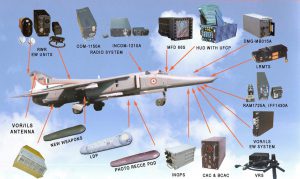 Radio-guided surface-to-air weapons like the AS-7 Kerry are also employed. In the past, the plane was known to have carried tactical nuclear weapons, as well as the S-4 240-millimeter and UB-32 or UB-16 57-millimeter rockets. The capacity for dropping napalm, eight bombs weighing over 1000 pounds each, and firing flares is also possessed by the MiG-27. A six-barrel 23-millimeter rotating Gatling gun also resides under the craft’s body. The total of the weapons that can typically be carried on a combat mission with the plane is over 8000 pounds. While little is known about the Flogger’s performance within a war zone, it apparently is serving its air force consumers well, as it continues to currently be produced in India as the Bahadur, or “Valiant.”
Radio-guided surface-to-air weapons like the AS-7 Kerry are also employed. In the past, the plane was known to have carried tactical nuclear weapons, as well as the S-4 240-millimeter and UB-32 or UB-16 57-millimeter rockets. The capacity for dropping napalm, eight bombs weighing over 1000 pounds each, and firing flares is also possessed by the MiG-27. A six-barrel 23-millimeter rotating Gatling gun also resides under the craft’s body. The total of the weapons that can typically be carried on a combat mission with the plane is over 8000 pounds. While little is known about the Flogger’s performance within a war zone, it apparently is serving its air force consumers well, as it continues to currently be produced in India as the Bahadur, or “Valiant.”
 The MiG-27 family are the strike and ground attack optimized variants of the MiG-23, and as such forms an important part of Russia’s offensive inventory. The MiG-27 designation originally applied to a range of Mikoyan design studies aimed to meet a requirement for a modern day Shturmovik that was eventually met by the Sukhoi Su-25. Instead the MiG-27 is the definitive strike/ground attack member of the “Flogger” MiG-23/27 family. The ground attack MiG-23s, as described in the previous entry, were regarded as interim ground attack aircraft pending the arrival of the optimized MiG-27. Compared with the MiG-23, the MiG-27 features simplified air intakes (as opposed to the F-4 style variable intake ramps of the MiG-23 optimized for high end performance) and simplified two stage afterburner nozzles. An extra external hardpoint and strengthened main undercarriage permit the carriage of over 4000kg (8820lb) of armament. Perhaps its most distinctive feature is the duckbill nose (which it shares with ground attack MiG-23s) which features a laser rangefinder and other sensors. The MiG-27 features advanced nay attack systems allowing all weather operations, and can be used in the tactical reconnaissance role carrying various recce pods.
The MiG-27 family are the strike and ground attack optimized variants of the MiG-23, and as such forms an important part of Russia’s offensive inventory. The MiG-27 designation originally applied to a range of Mikoyan design studies aimed to meet a requirement for a modern day Shturmovik that was eventually met by the Sukhoi Su-25. Instead the MiG-27 is the definitive strike/ground attack member of the “Flogger” MiG-23/27 family. The ground attack MiG-23s, as described in the previous entry, were regarded as interim ground attack aircraft pending the arrival of the optimized MiG-27. Compared with the MiG-23, the MiG-27 features simplified air intakes (as opposed to the F-4 style variable intake ramps of the MiG-23 optimized for high end performance) and simplified two stage afterburner nozzles. An extra external hardpoint and strengthened main undercarriage permit the carriage of over 4000kg (8820lb) of armament. Perhaps its most distinctive feature is the duckbill nose (which it shares with ground attack MiG-23s) which features a laser rangefinder and other sensors. The MiG-27 features advanced nay attack systems allowing all weather operations, and can be used in the tactical reconnaissance role carrying various recce pods.
The MiG-27 first flew in prototype form in 1972. The initial production MiG-27 was soon followed by the MiG-27K (“Flogger-D”). NATO’s “Flogger-J” designation covers the improved MiG-27D, MiG-27M and MiG-27K (“Flogger-J2”) with a TV/laser designator. Outside the CIS India is the only MiG-27 export customer, where it has been built under license. India calls its aircraft MiG-27M Bahadur, although Mikoyan refers to them as MiG-27Ls.
One Soyuz/Khachaturov R-29B-300 turbojet, rated at 78.40 kN (17625 lb st) dry and 112.7 kN (25335 lb st) with max afterburning; fixed air intakes and two-position (on/off) afterburner nozzle consistent with primary requirement of transonic speed at low altitude; internal fuel capacity 5400 litres (1426 US gallons; 1188 Imp gallons); provision for up to three 790 litre (209 US gallon; 174 Imp gallon) external tanks.
(basic MiG-27): PrNK-23 nav/attack system; SAU-1 automatic flight control system; INS; SPS-141 IR jammer; RI-65 16-item vocal warning system; SUA-1 angle of attack indicator; SG-1 radar warning system; SO-69 transponder; SRO-1P IFF; RV-5R/RV-10 radio altimeters; Fone telemetry system; bullet-shaped antenna above each glove pylon associated with missile guidance.
| MiG-27 Flogger D Specification | ||
| Prime contractor: | Mikoyan-Gurevich Design Bureau | |
| Country of origin: | Soviet Union | |
| NATO code: | Flogger D | |
| Function: | Ground-attack | |
| Crew: | 1 | |
| Year: | 1973 | |
| In-service year: | 1978 | |
| Power plant: | One Soyuz/Khachaturov R-29B-300 afterburning turbojet | |
| Thtust: | 25,300 lb. | 11,500 kg. |
| Dimensions | ||
| Wing span: | ||
| Fully spread | 45 ft. 8 in. | 13.97 m. |
| Fully swept | 26 ft. 7 in. | 7.78 m. |
| Length: | 56 ft. (including nose probe) | 17.08 m. (including nose probe) |
| Height: | 16 ft. 5 in. | 5.00 m. |
| Weight: | ||
| Empty | 26,198 lb. | 11,908 kg. |
| Max. takeoff | 44,660 lb. | 20,300 kg. |
| Performance | ||
| Ceiling: | 45,900 ft. | 14.000 m. |
| Speed: | 1,170 mph. | 1,885 km/h. |
| Range: | ~670 miles (on internal fuel) 1,304 miles (with external fuel tanks) |
~1,080 km. (on internal fuel) 2,100 km. (with external fuel tanks) |
| Armament | ||
| One GSh-6-30 30mm six-barrel cannon with 260 rounds. Max. external weapons load of over 4,000 kg. (8,800 lb.) include laser, R-3S (AA-2a “Atoll-A”), R-13M (AA-2d “Atoll-D”), R-60 (AA-8 “Aphid”) AAMs., Kh-23 (AS-7 “Kerry”), Kh-25ML (AS-10 “Karen”), Kh-25PM (AS-12 “Kegler”), Kh-29 (AS-14 “Kedge”), Kh-31P (“AS-17 Krypton”), Kh-35 (“AS-20 Kayak”) ASMs., S-5, S-8, S-13, S-24 unguided rockets, KAB-500, KAB-1500L guided bombs, FAB-250, FAB-500, FAB-1500 unguided bombs, RBK-500 cluster bombs, BetAB-500 concrete-piercing bombs, ZAB-500 napalm bombs, two tactical nuclear bombs, dispenser weapons, and three fuel tanks. |
||
| Known Variants | ||
| MiG-27D, MiG-27J, MiG-27K, MiG-27M, MiG-27MD, MiG-27MLA | ||
| Operators | ||
| India, Kazakhstan, Russia, Ukraine | ||
| Aircraft’s Price | ||
| 1996 – $15 millions. | ||
